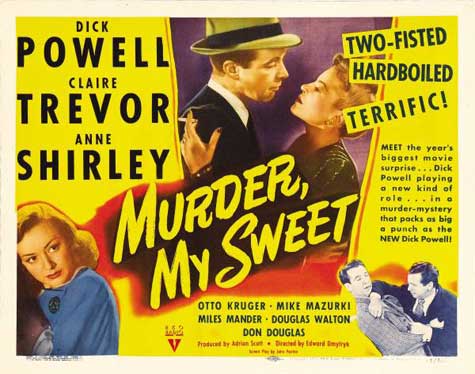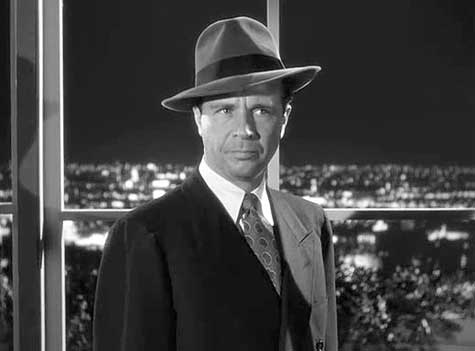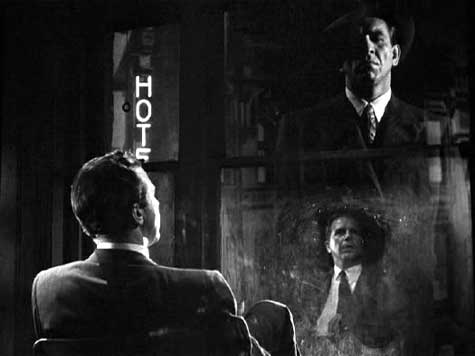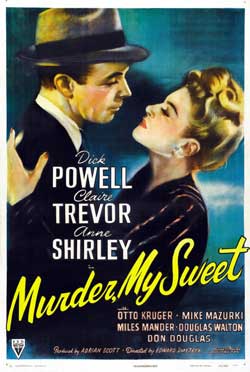
To celebrate the 70th anniversary of film noir’s landmark year, we’re looking at the six key noirs of 1944: Double Indemnity, Laura, Murder My Sweet, Phantom Lady, When Strangers Marry, and The Woman In the Window. Last week we looked at Otto Preminger’s adaptation of Vera Caspary’s Laura. Today we look at Edward Dmytryk’s Murder My Sweet.
Raymond Chandler’s Philip Marlowe is the most famous private eye to ever walk the mean streets of American crime fiction. He’s gotten more traction than Sam Spade (who only headlined one novel and a handful of stories by Dashiell Hammet), and he’s outlasted his most famous successor, Mickey Spillane’s Mike Hammer. As a literary creation, he’s iconic: the raincoat and snap brim hat, the cigarettes, the smartass remarks, the office bottle, the tendency to get knocked over the head and wake up next to a dead body. He is a pivotal American heroic archetype, the lonely but honest private investigator. If the English have Sherlock Holmes, then Americans have Phillip Marlowe.
In many ways, Chandler was an impressive writer with a distinctive vision, but he was also blessed to work at just the right time. He famously disdained Hollywood, but Hollywood loved his laconic P.I. and adapted him to the screen several times. The most famous incarnation was Howard Hawks’ version of The Big Sleep starring Humphrey Boart, but Marlowe actually got his start a little earlier when Dick Powell played him for director Edward Dmytryk in Murder, My Sweet.

The film is based on Chandler’s second Marlowe novel, Farwell, My Lovely. The complicated story centers around a towering ex-boxer named Moose Malloy (Mike Mazurki) who is recently out of prison and looking for his long lost love, a dancer named Velma. He engages Marlowe to track her down, but soon the private eye has another client, a foppish gent named Lindsay Marriott. He wants Marlowe to accompany him to retrieve a stolen jade necklace. Marlowe tags along to a midnight meeting in the woods, but someone saps him on the back of the head. When he wakes up, Marriott is dead. He discovers that the stolen necklace belonged to the beautiful Helen Grayle (Clare Trevor), the much younger wife of a rich old man. Mrs. Grayle doesn’t seem in a terrible hurry to get her necklace back, and her stepdaughter, Ann (Anne Shirley) confides to Marlowe that there’s something funny going on between Mrs. Grayle and a sham doctor named Jules Amthor (Otto Kruger).
And so on and so forth. I’ve seen this movie many times, and I’ve read the novel twice, but I don’t think I could pass a test on the story’s plot. Chandler was never much of a plotter, really. He once wrote that the talent to construct a good puzzle is not necessarily to be found in the same brain that can write believable characters and dialogue. The Big Sleep is famously confusing, but for my money, Murder, My Sweet is even more baffling. Part of the problem is that Dmytryk lets the exposition bog down a bit, especially toward the end. Hawks kept The Big Sleep going so fast that it was only afterwards that you realized you didn’t know what the hell had happened. Here, Dmytryk occasionally slows things down to try to iron out the details, to the detriment of both the pace and the plot.

What’s important here, though, is that Murder, My Sweet is really a movie about tone and style—and in this respect it’s almost shockingly good. It smartly rigs up a flashback device to allow Marlowe to narrate his adventure while being questioned by the cops (a far better idea than Robert Montgomery’s goofy subjective camera in Lady in The Lake). It also employs a terrific score by the great Roy Webb that manages to be both intimately smoky and epic at the same time, in much the same way the scores of The Maltese Falcon and The Big Sleep gave their pictures the feeling of nightbound urban adventure.
Dmytryk’s most important collaborator here is veteran RKO cinematographer Harry Wild. Together on this film they helped create the look of film noir. There’s an early shot of Marlowe sitting in his office at night, smoking and looking out the window as neon signs for Chinese food reflect off the glass. This single shot is damn near a dictionary definition of the noir style of high contrast black and white, with light scrupulously used to frame faces and capture drifts of smoke. And the entire film is just as beautiful.
 Of course, a Philip Marlowe movie is only as good as its Philip Marlowe and Murder, My Sweet has a fascinating lead performance from Dick Powell. At the time, Powell was most notable as a song and dance man (in fact, the legend goes that the studio changed the name of the movie from Farewell, My Lovely because it sounded too much like a musical), and this film marked his entrance into tough guy territory. Interestingly though, Powell isn’t much of a tough guy. There’s a smug quality about him—and he delivers the wisecracks with relish—but there was also a faint whiff of the maladroit about Dick Powell. He takes the requisite cracks on the noggin with aplomb, but he lacks Bogart’s steel spine. Understand, though, that this isn’t a criticism. You could even argue that Powell’s portrayal hews closer to the Marlowe of the books. Unlike Spillane’s borderline psychotic Mike Hammer, Chandler’s Marlowe is essentially a sensitive man with a tough shell. His interactions with the ugliness of the underworld always take a toll on him, and Powell’s vulnerable enough that you’re not sure if he’ll make it through in one piece. It’s difficult to imagine Bogart enduring the strange sequence here in which Powell is drugged by a quack doctor and fumbles through a surrealist landscape, nor is it easy to picture big Mike Mazurki manhandling Bogart like a cheap rag doll. Powell’s performance gives the movie the center of ambiguity that many people felt was lacking in The Big Sleep.
Of course, a Philip Marlowe movie is only as good as its Philip Marlowe and Murder, My Sweet has a fascinating lead performance from Dick Powell. At the time, Powell was most notable as a song and dance man (in fact, the legend goes that the studio changed the name of the movie from Farewell, My Lovely because it sounded too much like a musical), and this film marked his entrance into tough guy territory. Interestingly though, Powell isn’t much of a tough guy. There’s a smug quality about him—and he delivers the wisecracks with relish—but there was also a faint whiff of the maladroit about Dick Powell. He takes the requisite cracks on the noggin with aplomb, but he lacks Bogart’s steel spine. Understand, though, that this isn’t a criticism. You could even argue that Powell’s portrayal hews closer to the Marlowe of the books. Unlike Spillane’s borderline psychotic Mike Hammer, Chandler’s Marlowe is essentially a sensitive man with a tough shell. His interactions with the ugliness of the underworld always take a toll on him, and Powell’s vulnerable enough that you’re not sure if he’ll make it through in one piece. It’s difficult to imagine Bogart enduring the strange sequence here in which Powell is drugged by a quack doctor and fumbles through a surrealist landscape, nor is it easy to picture big Mike Mazurki manhandling Bogart like a cheap rag doll. Powell’s performance gives the movie the center of ambiguity that many people felt was lacking in The Big Sleep.
Of course, The Big Sleep is more famous and features a more highly regarded director and bigger stars, but—make no mistake—Murder, My Sweet is indispensable. More than any other Marlowe film, it positions the detective story firmly within the decidedly unheroic milieu of film noir.
Jake Hinkson, The Night Editor, is the author of The Posthumous Man and Saint Homicide.
Read all posts by Jake Hinkson for Criminal Element.

Saw this one for the first time recently and thoroughly liked it. Notable is the frequency in which PM gets knocked out. It’s almost a running gag.